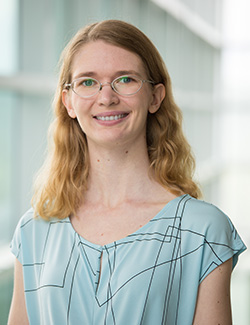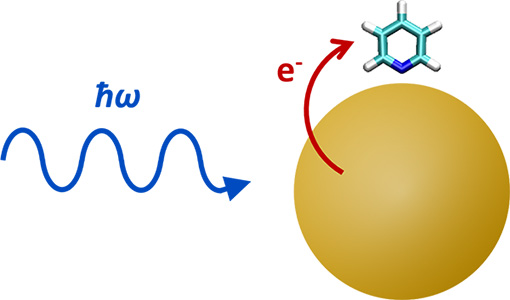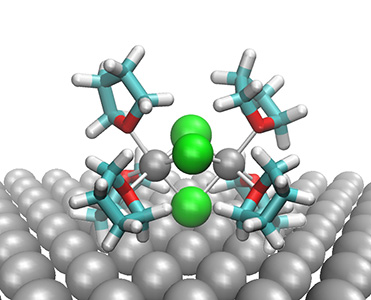Rebecca L. M. Gieseking
 Assistant Professor of Chemistry
Assistant Professor of Chemistry
Degrees
Northwestern University, Postdoc
Georgia Institute of Technology, Ph.D.
Furman University, B.S. and M.S.
Profile
Research Summary
Our research is focused on developing computational models to understand materials for emerging energy technologies in the fields of solar energy, batteries, and fuel generation. The critical steps in these technologies involve electron transfer at complex interfaces. We will focus on using theoretical and computational approaches to reveal design principles that connect molecular structure to the important material properties required for these applications, with the goal of developing an understanding that can be used to guide experimental studies.
Photochemistry and Excited-State Dynamics
Storing solar energy as chemical fuels is critical to reduce our dependence on fossil fuels and meet increasing energy demands. We are particularly interested in photocatalysis involving plasmonic metal nanostructures because of their strong and highly tunable absorption spectra, focusing on understanding how the structural features that influence the mechanism, yield, and lifetime of the charge-transfer state can be tuned to enhance photocatalysis.

Electrochemistry
Reactions at electrochemical interfaces are critical for energy technologies such as fuel generation and next-generation batteries. In many cases, the efficiency of these technologies is limited by large overpotentials and limited selectivity for the desired products. We are developing computational approaches that allow us to explore reaction mechanisms at electrochemical interfaces, gaining understanding of the features of the electrode surface and solution composition that can be tuned to optimize the efficiency of these reactions for improved device performance.

Selected Publications
- Gieseking RLM. Plasmons: untangling the classical, experimental, and quantum mechanical definitions. Mater Horiz. 2022 Jan 4;9(1):25-42. doi: 10.1039/d1mh01163d.
- Gieseking RLM. A new release of MOPAC incorporating the INDO/S semiempirical model with CI excited states. J Comput Chem. 2021 Feb 15;42(5):365-378. doi: 10.1002/jcc.26455.
- Ceylan YS, Gieseking RLM. Hydride- and halide-substituted Au9(PH3)83+ nanoclusters: similar absorption spectra disguise distinct geometries and electronic structures. Phys Chem Chem Phys. 2021 Aug 3. doi: 10.1039/d1cp02761a.
- Demirel G, Gieseking RLM, Ozdemir R, Kahmann S, Loi MA, Schatz GC, Facchetti A, Usta H. Molecular engineering of organic semiconductors enables noble metal-comparable SERS enhancement and sensitivity. Nat Commun. 2019 Dec 3;10(1):5502. doi: 10.1038/s41467-019-13505-7.
- Gieseking RLM. Third-Order Nonlinear Optical Properties of Ag Nanoclusters: Connecting Molecule-Like and Nanoparticle-Like Behavior. Chemistry of Materials 2019, 31, 6850-6859. DOI: 10.1021/acs.chemmater.9b01290.
- Gieseking RLM, Ratner MA, Schatz GC. Benchmarking Semiempirical Methods to Compute Electrochemical Formal Potentials. Journal of Physical Chemistry A 2018, DOI: 10.1021/acs.jpca.8b05143.
- Gieseking RL, Ratner MA, Schatz GC. Theoretical Modeling of Voltage Effects and the Chemical Mechanism in Surface-Enhanced Raman Scattering. Faraday Discussions 2017, 205, 149-171.
- Gieseking RL, Ratner MA, Schatz GC. Semiempirical Modeling of Electrochemical Charge Transfer. Faraday Discussions 2017, 199, 547-563.
- Gieseking RL, Ratner MA, Schatz GC. Quantum Mechanical Identification of Quadrupolar Plasmonic Excited States in Silver Nanorods. Journal of Physical Chemistry A 2016, 120, 9324-9329.
- Gieseking RL, Ratner MA, Schatz GC. Semiempirical Modeling of Ag Nanoclusters: New Parameters for Optical Property Studies Enable Determination of Double Excitation Contributions to Plasmonic Excitation. Journal of Physical Chemistry A 2016, 120, 4542-4549. (ACS Editor’s Choice)